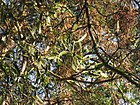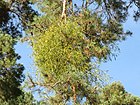Note: This is a project under development. The articles on this wiki are just being initiated and broadly incomplete. You can Help creating new pages.
Viscum album - Mistletoe
Viscum album is a species of mistletoe in the family Santalaceae, commonly known as European mistletoe, common mistletoe or simply as mistletoe. It is native to Europe and western and southern Asia.
Uses
breast cancer, internal bleeding, hemorrhoids, gout, headache, whooping cough, asthma, Diarrhea, dizziness
Parts Used
Chemical Composition
Plant proteins with high affinity to specific cellular glycoconjugates: Lectin I (D-galactose-and N-acetyl-D-galactosamine, and sialoglycoproteins specific lectin)37,38,39,40,41, Lectin II and III (N-acetyl-D-galactosamine specific proteins).[1]
Common names
| Language | Common name |
|---|---|
| Kannada | |
| Hindi | |
| Malayalam | |
| Tamil | |
| Telugu | |
| Marathi | NA |
| Gujarathi | NA |
| Punjabi | NA |
| Kashmiri | NA |
| Sanskrit | |
| English | Common Mistletoe, European mistletoe |
Properties
Reference: Dravya - Substance, Rasa - Taste, Guna - Qualities, Veerya - Potency, Vipaka - Post-digesion effect, Karma - Pharmacological activity, Prabhava - Therepeutics.
Dravya
Rasa
Tikta (Bitter), Kashaya (Astringent)
Guna
Laghu (Light), Ruksha (Dry), Tikshna (Sharp)
Veerya
Ushna (Hot)
Vipaka
Katu (Pungent)
Karma
Kapha, Vata
Prabhava
Habit
Identification
Leaf
| Kind | Shape | Feature |
|---|---|---|
| Simple | Alteranate | Pairs of oval green leaves |
Flower
| Type | Size | Color and composition | Stamen | More information |
|---|---|---|---|---|
| Unisexual | 2-4cm long | Yellow | 5-20 | mistletoe is dioecious meaning male and female flowers are produced on separate plants |
Fruit
| Type | Size | Mass | Appearance | Seeds | More information |
|---|---|---|---|---|---|
| General | 7–10 mm | Waxy white berries in clusters of two to six | With hooked hairs | - | {{{6}}} |
Other features
List of Ayurvedic medicine in which the herb is used
- Vishatinduka Taila as root juice extract
Where to get the saplings
Mode of Propagation
How to plant/cultivate
A parasitic plant, growing on the branches of several deciduous species of trees. It is not usually found on coniferous trees, though the subspecies V.[3]
Commonly seen growing in areas
Photo Gallery
References
External Links
- Ayurvedic Herbs known to be helpful to treat breast cancer
- Ayurvedic Herbs known to be helpful to treat internal bleeding
- Ayurvedic Herbs known to be helpful to treat hemorrhoids
- Ayurvedic Herbs known to be helpful to treat gout
- Ayurvedic Herbs known to be helpful to treat headache
- Ayurvedic Herbs known to be helpful to treat whooping cough
- Ayurvedic Herbs known to be helpful to treat asthma
- Ayurvedic Herbs known to be helpful to treat Diarrhea
- Ayurvedic Herbs known to be helpful to treat dizziness
- Herbs with Stem used in medicine
- Herbs with Leaves used in medicine
- Herbs with common name in English
- Habit - Perennial
- Index of Plants which can be propagated by Seeds
- Index of Plants which can be propagated by Cuttings
- Herbs that are commonly seen in the region of Grows on the branches of many trees
- Herbs that are commonly seen in the region of Especially on calcareous soils
- Herbs that are commonly seen in the region of On poplars
- Herbs
- Santalaceae





